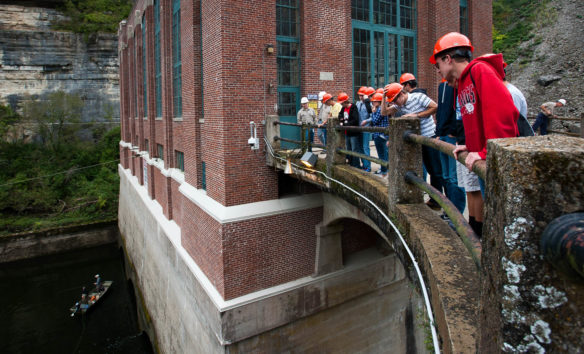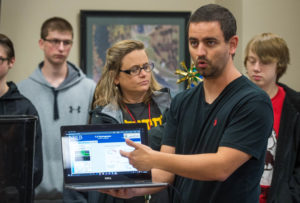
High school students from Burgin Independent School tour the Dix Dam hydroelectric plant at Kentucky Utilities’ E.W. Brown Generating Station in Mercer County. Students in Chad Terrell’s energy and power foundations class visited the plant as part of their study of how water can be used to create electricity.
Photo by Bobby Ellis, Sept. 30, 2016
By Mike Marsee
michael.marsee@education.ky.gov
The smokestacks at E.W. Brown Generating Station are easily visible from Burgin Independent School, and thanks to a new career pathway, so are the opportunities beneath them.
The classes being taught by Chad Terrell combine engineering, mathematics and science as students learn how things work at the massive Kentucky Utilities (KU) plant, gaining skills that could someday help them get jobs there or at another plant like it.
“They’re not only learning academic skills, but they’re also learning those technical skills that employers are looking for,” Terrell said. “I think it’s really good for our students to get this kind of real-life experience.”
Carl Korte, a junior who is one of 16 students enrolled in the inaugural course, said he jumped at the chance to take it when he was filling out his schedule this spring.
“They said that this could be revolutionary to our school and the state of Kentucky. I was looking into being an engineer myself, so I decided why not get ahead of everybody else in the game and join this class,” he said.
Burgin is among the first schools in Kentucky to offer these energy and power technology courses that are part of the Southern Regional Education Board’s Advanced Career program, which offers eight career pathways that blend technical and academic skills. The energy and power curriculum is for students who have an interest in energy careers and are willing to learn and apply mathematics and science knowledge and technical skills to complete real-world assignments.
The courses align with the energy technology engineering career pathway approved by the Kentucky Board of Education in 2013. Career pathways consist of a series of connected programs in which each step prepares students to move to the next level of education or employment.
“When employers and education combine efforts to support launch of a career pathway through student engagement with active employers, training facility improvements, targeted teacher training, and specific curriculum, the momentum to meet the needs of our Kentucky workforce is certainly increased,” said Marissa Hancock, an academic consultant in the Kentucky Department of Education’s Office of Career and Technical Education.
Burgin’s pathway consists of four courses intended to increase the number of students who leave high school prepared for further study, advanced training and careers in energy and power. Terrell is teaching energy and power foundations this semester, and he will teach energy transmission and distribution during the spring semester.
“We’re teaching two courses this year to pilot it, and next year we’ll be teaching four courses,” Terrell said.
Terrell was trained to teach the courses at Marshall University’s Weisberg Division of Engineering, which received a grant to support an energy and power outreach program for high school students. Marshall is implementing SREB’s Advanced Career energy and power curricula in West Virginia and nearby states.
Terrell’s students already have made two visits to the E.W. Brown plant on the banks of Lake Herrington, where electricity is generated using four different sources: water, coal, natural gas and solar energy.
On their most recent visit, the students presented the results of their work to develop an efficient water-powered turbine to KU engineers before touring the hydroelectric generating station at Dix Dam.
“We only had two weeks to do this project – one week to research and one week to build it,” Korte said. “It was great to hear from the people who actually know about this.”
Terrell said he wasn’t sure what he was getting into when Burgin administrators, who had been researching possible career pathways, asked him if he would be interested in teaching an energy and power course.
“I had no clue what that is,” said Terrell, whose background is in physics.
The school won a $10,000 grant last year from Corning Inc. – which has a manufacturing facility in nearby Harrodsburg –that financed the class, including computers and other equipment required for it, and paid for Terrell’s training.

Chad Terrell, who teaches the energy and power foundations class at Burgin Independent School, presents data gathered by his students to Kentucky Utilities employees at the E.W. Brown Generating Station during a field trip to the power plant. Terrell was trained this summer to teach the first two courses in what will become a four-course career pathway.
Photo by Bobby Ellis, Sept. 30, 2016
Terrell spent two weeks at the beginning of this summer at Marshall training for the first course and two weeks at the end of the summer training for the second. Jim Berto, a research associate with SREB, said the two-week trainings in this and the other Advanced Career programs help teachers better understand what their students will be learning.
“Teachers work through each of the six course projects students are required to do. This enables them to anticipate what problems students may have beforehand,” Berto said.
Terrell said the trainings were unlike any he had experienced before.
“They wouldn’t tell us what to do. They were like, ‘Figure it out,’” he said. “I kind of understand how the kids feel when I’m not just giving them answers.
“In this class, you’re there to guide them, to make sure they’re on track. They’re used to having the right or wrong answer, but in this class there is no right or wrong answer. There might just be a better answer.”
Terrell said he wants students to approach their research as if a supervisor had asked them to do it, and junior Trenton Freeland said that’s exactly how he views it.
“I consider it more as a job than a class, because most of this class is modeled after what a company would want you to do. You have to do your reports and models and graphs the way a company would want you to do it,” Freeland said.
There are six projects within the first course, from studying how direct motors work and building a working motor to examining heat exchangers.
KU engineers also visit the class from time to time to share what they know and view students’ presentations.
“We’re willing to work with the school to provide any kind of hands-on experience that we can give them, ways that we can show them in real life some of the things that they’re studying,” said Nick Caton, a shift supervisor and training coordinator at the plant.
Terrell said the E.W. Brown plant and its employees are a tremendous resource.
“The way this program’s set up, we couldn’t have lined it up more perfectly to have our school here and a power plant down the road,” he said. “They can teach us, and at same time, maybe were putting out quality people that they could employ later on.”
Caton said KU employees are happy to help teach students who might someday work alongside them.
“If we can recruit people who already have skills in the field before they ever get to work, then obviously it puts us at an advantage when they start,” he said. “Having programs like this in place will give us a good hiring pool to choose from.”
MORE INFO …
Chad Terrell chad.terrell@burgin.kyschools.us
Nick Caton nick.caton@lge-ku.com




Leave A Comment